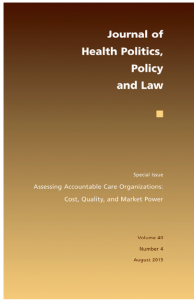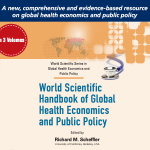 “‘Accessing Accountable Care Organizations: Cost, Quality, and Market Power,’ a special issue of the Journal of Health Politics, Policy and Law (volume 40, issue 4), is an in-depth look at accountable care organizations (ACOs): networks of hospitals, physicians or other health care providers that share financial and medical responsibility for the coordinated care of a patient.
“‘Accessing Accountable Care Organizations: Cost, Quality, and Market Power,’ a special issue of the Journal of Health Politics, Policy and Law (volume 40, issue 4), is an in-depth look at accountable care organizations (ACOs): networks of hospitals, physicians or other health care providers that share financial and medical responsibility for the coordinated care of a patient.
Now numbering over 700 throughout the United States, ACOs were rare prior to the passage of the Affordable Care Act. Their increased presence has sparked a debate about issues important to patients, providers, and taxpayers throughout the nation. ‘Integrated health delivery systems and accountable care organizations are becoming ubiquitous in our health care system,’ Richard Scheffler, special issue editor, states. ‘They potentially could bend the cost curve and improve the quality of care, but they also present a threat to the competitiveness of health care markets.'”
Read the full press release here.
The full journal can be found here.

 Professor Scheffler is the editor of a just released 3-volume Global Health Policy and Economics Handbook through World Scientific Publishing. The official launch was January 3, 2016 at the American Economics Association meeting in San Francisco.
Professor Scheffler is the editor of a just released 3-volume Global Health Policy and Economics Handbook through World Scientific Publishing. The official launch was January 3, 2016 at the American Economics Association meeting in San Francisco.

 The University of Chicago School of Social Service Administration issued an announcement on the release of the “Assessing Accountable Care Organizations: Cost, Quality, and Market Power” special issue of the Journal of Health Politics, Policy and Law (volume 40, issue 4). The special issue is “an in-depth look at accountable care organizations (ACOs): networks of hospitals, physicians, or other health care providers that share financial and medical responsibility for the coordinated care of a patient.” The special issue was co-edited by Colleen M. Grogan, editor of JHPPL, Professor; Co-Chair, Center for Health Administration Studies; Faculty Chair, Graduate Program in Health Administration and Policy; Editor, Journal of Health Politics, Policy and Law at the University of Chicago and by Richard M. Scheffler, Director of the Petris Center, with much of the content supported through the Nicholas C. Petris Center, with funding from the California Attorney General’s office.
The University of Chicago School of Social Service Administration issued an announcement on the release of the “Assessing Accountable Care Organizations: Cost, Quality, and Market Power” special issue of the Journal of Health Politics, Policy and Law (volume 40, issue 4). The special issue is “an in-depth look at accountable care organizations (ACOs): networks of hospitals, physicians, or other health care providers that share financial and medical responsibility for the coordinated care of a patient.” The special issue was co-edited by Colleen M. Grogan, editor of JHPPL, Professor; Co-Chair, Center for Health Administration Studies; Faculty Chair, Graduate Program in Health Administration and Policy; Editor, Journal of Health Politics, Policy and Law at the University of Chicago and by Richard M. Scheffler, Director of the Petris Center, with much of the content supported through the Nicholas C. Petris Center, with funding from the California Attorney General’s office.


 An article by Petris Center Director Richard M. Scheffler and Christopher Whaley, H. E. Frech III, Benjamin R. Handel, Liora Bowers, and Carol J. Simon was published in the Review of Industrial Organizations journal on July 15, 2015.
An article by Petris Center Director Richard M. Scheffler and Christopher Whaley, H. E. Frech III, Benjamin R. Handel, Liora Bowers, and Carol J. Simon was published in the Review of Industrial Organizations journal on July 15, 2015.
 “‘Accessing Accountable Care Organizations: Cost, Quality, and Market Power,’ a special issue of the Journal of Health Politics, Policy and Law (volume 40, issue 4), is an in-depth look at accountable care organizations (ACOs): networks of hospitals, physicians or other health care providers that share financial and medical responsibility for the coordinated care of a patient.
“‘Accessing Accountable Care Organizations: Cost, Quality, and Market Power,’ a special issue of the Journal of Health Politics, Policy and Law (volume 40, issue 4), is an in-depth look at accountable care organizations (ACOs): networks of hospitals, physicians or other health care providers that share financial and medical responsibility for the coordinated care of a patient.